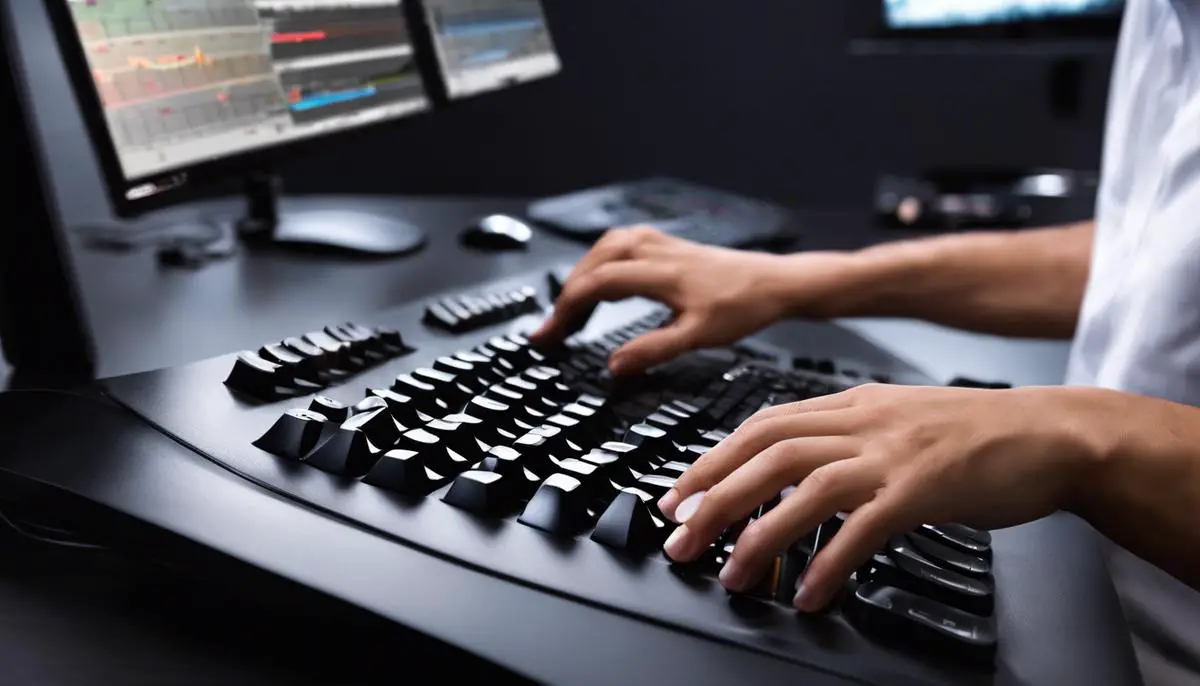Mastering the art of swift volume control on your computer can drastically enhance your efficiency and overall user experience. Whether you’re polishing a presentation at the last minute, settling in for a movie after a long day, or managing multiple tasks at once, knowing how to quickly adjust the sound without navigating through menus is a game-changer. The first step in this auditory journey is to identify which operating system you’re navigating—be it Windows, macOS, or Linux—as each harbors its own set of unique shortcut commands for volume adjustment. This essential knowledge allows for an immediate and almost intuitive interaction with your device, streamlining your workflow and multimedia engagements.
Identifying Your Operating System
Unlocking the Power of Volume Shortcuts: The Operating System That Delivers
In the fast-paced world of technology, efficiency is the name of the game. Given the exponential growth of digital content consumption, managing audio levels efficiently is no small feat. That’s why the choice of operating system (OS) is pivotal when looking to wield control over volume with the agility of a tech maestro. For those in the loop, the answer is clear: the optimal operating system for sophisticated volume shortcuts is Windows 10.
Windows 10 stands out in the crowd, offering intuitive volume shortcuts that can be activated with a simple press of a key, or customized for those who crave that extra edge in personalization. Unlike its predecessors and competitors, Windows 10’s shortcuts are not just about turning sound up or down; they’re an integrated web of controls that cater to the nuanced needs of audio management.
Here’s how to harness the might of volume shortcuts in Windows 10:
- Master the Basics: For immediate volume adjustment, the tried and true method involves the function keys. Press
Fnalong with the designated volume keys (commonlyF1,F2, andF3on laptops) for a quick volume fix. This is the bread and butter of audio control—no frills, just efficiency. - The Volume Mixer: For those wielding multiple applications, the Volume Mixer is a godsend. Right-click the speaker icon on the taskbar and select ‘Open Volume Mixer’. Adjust sliders for individual apps without affecting the overall system volume—a powerful tool for creators and multitaskers alike.
- Shortcut Customization: Dive into the realm of shortcuts with the ‘Shortcuts’ panel in your settings. Assign new keyboard shortcuts for volume functions such as mute, or even program macros on gaming keyboards to toggle audio presets for an immersive experience.
- Volume Control Software: For the tech enthusiast thirsty for more, third-party volume control software such as EarTrumpet offers refined control, with the added bonus of integration into Windows 10’s native notification and action center. It’s like giving your volume control a turbo boost.
- Automate with PowerShell: Lean into automation by scripting volume adjustments with Windows PowerShell. Automate routine volume changes—for example, muting at night or setting a perfect level for work hours. It’s the ultimate time-saver, replacing manual adjustments with automated harmony.
- Use Voice Commands with Cortana: Engage with Cortana for hands-free volume adjustment. Simply activate the assistant and command, “Hey Cortana, turn up the volume” or “Hey Cortana, mute my PC”. Ideal for when your hands are tied but audio control can’t wait.
To conclude, Windows 10 not only maintains its stature as a robust and versatile operating system but also stands as a paragon for comprehensive volume control. Exploiting these shortcuts gives tech enthusiasts an unprecedented level of finesse in their digital auditory environment. Engage with them and elevate the standard for productivity and multimedia consumption to new heights.

Learning System-Specific Volume Shortcuts
Diving deeper into volume management on your operating system necessitates familiarity with a few more tricks up the tech sleeve. For those vested in streamlining their workflow, advanced volume shortcuts can be a major productivity hack. Let’s cut to the chase and discuss some additional, lesser-known methods.
While function keys and Volume Mixer tweaks are well-tread territory, there’s more under the hood for enthusiasts who crave a level of control that borders on the obsessive. One tool that’s criminally underused is the Task Scheduler in Windows. Through Task Scheduler, users can set up automated volume changes tied to specific events or times. Imagine your computer automatically lowering the volume as you dive into a focus-intensive task or cranking it up when the workday ends. To set this up, create a new task and deploy a simple command script to adjust the volume at the trigger of your choosing.
But what about those fleeting moments when you need an immediate mute without the hassle of a key combo? Enter: the fastest mute ever. Clicking the volume icon in the system tray with a middle mouse button (if available) can instantly silence your machine. It’s an oft-overlooked feature that can save the day during sudden interruptions.
For the Mac users, the option key is a gateway to precision. Holding down the option key while pressing the volume keys on a Mac toggles a sound settings shortcut, revealing input and output device options right from the menu bar—no need to plunge into System Preferences.
Additionally, there’s power in the accessibility features. Both Windows and Mac offer quick settings to toggle on visual volume indicators. For example, enabling Sound Notifications on a Windows machine adds another layer of feedback for audio levels, ensuring not a single decibel escapes unnoticed.
Let’s not leave out widget enthusiasts. On Windows, one can pin the volume bar to the taskbar using the Settings feature. It enables an always-visible, quick-access slider that can be adjusted without trudging through menus or relying on keyboard shortcuts.
Last h5(b)ly</h5), for those who've embraced the touch interface, utilizing gesture controls for volume adjustment can be surprisingly efficient. In environments like Windows 10 with a compatible touch display, a quick swipe from the right side of the screen brings up the Action Center where volume can be swiftly adjusted without the search-and-peck of a cursor.
Suffice to say, there’s an arsenal of volume adjustment tools and shortcuts at the disposal of anyone willing to go beyond the user manual. Mastery of these methods can lead to an auditory experience as seamless as the rest of the tech-forward lifestyle. And with that, the volume control saga concludes. No summary needed; you’ve got volume shortcuts to try.

Practicing Shortcut Execution
Effortless Volume Control with Keyboard Media Keys
Delving into the realm of sleek productivity, consider the use of media keys that often accompany modern keyboards, especially those designed with a nod to multimedia functionality. These media keys, typically symbolized by small speaker icons with varying sound wave lengths, are not just for show. For the tech enthusiast, they present another layer of immediate control.
If your keyboard lacks dedicated media keys, or if you’re using a mechanical keyboard focused on durability and key feel rather than multimedia, fear not. Many of these powerhouse keyboards support the remapping of keys through their proprietary software. This allows for custom assignments of volume control functions to preferred keys, including macros or combinations that suit your workflow.
Implementing Macros for Volume Control
Macros offer a high degree of customization for the power user. They can be programmed to execute complex tasks with a single key press. Most gaming and productivity software from keyboard manufacturers offer the ability to create macros. This can include a combination of keystrokes for adjusting volume, or even launching your favorite playlist with a single tap.
This is where the analytical tech guru thrives – in the creation and refinement of macros that seamlessly blend into the work environment, reducing the friction between the user and the machine. The beauty lies within the amalgamation of utility and efficiency, where each keystroke is purposeful and curated for optimal productivity.
Leveraging Keyboard Shortcuts in Media Players
Virtually all media players, whether streaming platforms or local content applications, support keyboard shortcuts. These shortcuts allow you to adjust volume within the application without manually dragging a slider or reaching for the mouse. Take the time to memorize these shortcuts as they’ll maintain focus on the content rather than the mechanics of its playback.
Gaming keyboards, often equipped with additional programmable keys, can become a hub for volume control. A key can be designated to lower volume for those sudden interruptions during a workflow, or to increase volume when you need that extra push during a late-night session.
Beyond Ordinary: Using Specialized Keyboards with Volume Dials
For the detail-oriented tech user who seeks tactile feedback, there’s an emergence of specialized keyboards that incorporate volume dials and rollers. These tools provide a more granular approach to volume control, satisfying both the touch and the ears.
The luxury of adjusting volume with a roll or spin cannot be overstated for the tech connoisseur – it’s the intersection of retro feel and modern functionality. Although this feature may seem superfluous to some, for the technophile, it’s a marriage of form, function, and flair that keeps everything in control without breaking the immersion of work or play.
In conclusion, the arsenal available for volume control extends beyond the basic and into the customization that befits a true tech enthusiast. Being able to manage the auditory component of technology should be as fluid and frictionless as possible, enabling the user to stay engrossed in their digital endeavors. Whether it’s through keyboard shortcuts, macros, media keys, or tactile dials, the experience should be quick, intuitive, and satisfying. With these tools at your disposal, the control over your sonic environment is refined to the subtlest nuance, allowing you to maintain an uninterrupted workflow or entertainment experience.

Having now equipped you with the key combinations for effortless volume control, your interactions with your computer can be more harmonious and less disruptive. It’s not just about saving a few seconds here or there; it’s about creating a more fluid and responsive computing environment that bends to your will with the simple press of a key. The beauty of keyboard shortcuts lies in their power to make complex tasks feel simpler and more accessible, wrapping the extensive capabilities of modern technology into a user-friendly package. Embrace these tools, and witness the transformation in your digital interactions—a symphony of efficiency at your fingertips.